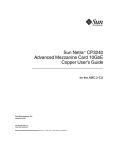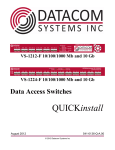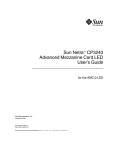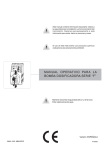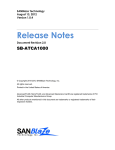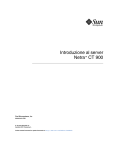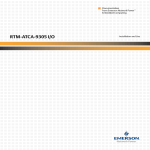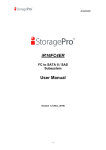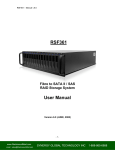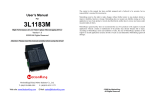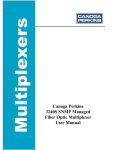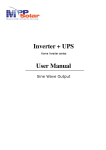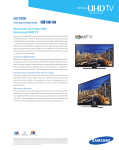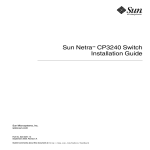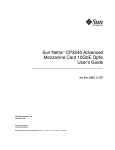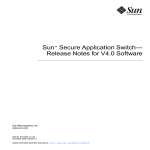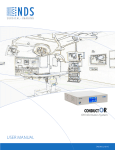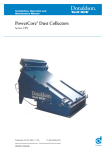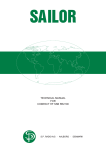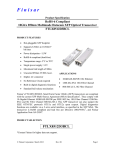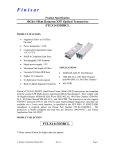Download Manual - SANBlaze Technology
Transcript
AdvancedTCA® Rear Transition Module for ATS1936 10-Gigabit Switch SB-RTM1936-SFP+ Configuration and Maintenance Guide August 2012 Rev 2.0 SB-RTM1936-SFP+ Configuration and Maintenance Guide © Copyright 2012 SANBlaze Technology, Inc. All rights reserved. Printed in the United States of America. AdvancedTCA®, MicroTCA®, and Advanced Mezzanine Card® are registered trademarks of PCI Industrial Computer Manufacturers Group. All other products mentioned in this document are trademarks or registered trademarks of their respective holders. Limited and Restricted Rights Legend If the documentation contained herein is supplied, directly or indirectly, to the U.S. Government, the following notice shall apply unless otherwise agreed to in writing by SANBlaze Technology, Inc. Use, duplication, or disclosure by the Government is subject to restrictions as set forth in subparagraph (b)(3) of the Rights in Technical Data clause at DFARS 252.227-7013 (Nov. 1995) and of the Rights in Noncommercial Computer Software and Documentation clause at DFARS 252.227-7014 (Jun. 1995). SANBlaze Technology, Inc. One Monarch Drive, Suite 204 Littleton, MA 01460 Page 2 1.978.679.1400 / www.SANBlaze.com SB-RTM1936-SFP+ Configuration and Maintenance Guide For Your Safety Warning: High voltages are present on shelf mid-plane. Disconnect all power before reaching into shelf. All slots must be covered with panels or boards and must be secured with thumbscrews after service has been completed. CAUTION: The shelf containing the board shall be installed in a restricted access area. If the board is installed in a system that is in turn installed in a closed or multi-unit rack assembly, the operating ambient temperature of the rack environment may be significantly greater than the room ambient. While the maximum ambient board operating temperature is 55C, for periods up to 3 days, consideration should be given to installing the unit in an environment compatible with the maximum recommended ambient temperature of 45C. External airflow must be provided at all times during operation to avoid damaging the board. Unused slots should be covered with blank panels to maintain airflow past the board. Do not expose this device to rain or other moisture. This board must be protected from static discharge and physical shock. Use the anti-static bag shipped with the product to handle the board. Wear a grounded wrist strap when servicing system components. Page 3 1.978.679.1400 / www.SANBlaze.com SB-RTM1936-SFP+ Configuration and Maintenance Guide Revision History Date Revision Summary of Corrections 8/13/2012 2.0 Initial SANBlaze revision Page 4 1.978.679.1400 / www.SANBlaze.com SB-RTM1936-SFP+ Configuration and Maintenance Guide Table of Contents For Your Safety ................................................................................................................................................ 3 Revision History ............................................................................................................................................... 4 Table of Contents .............................................................................................................................................. 5 Document Organization .................................................................................................................................... 7 Tables................................................................................................................................................................ 8 Figures .............................................................................................................................................................. 8 1 PRODUCT DESCRIPTION ....................................................................................... 9 1.1 Feature List ................................................................................................................................................. 10 1.2 Functional Block Diagram ......................................................................................................................... 11 1.3 Front-board Port Map ................................................................................................................................. 12 1.4 Key Components ........................................................................................................................................ 12 1.4.1 Broadcom BCM8726B 10-GbE Serial-to-XAUI Ethernet PHY..............................................................12 1.4.2 Broadcom BCM5464R 10/100/1000Base-T Ethernet PHY ....................................................................12 1.4.3 IPMI FRU ................................................................................................................................................12 1.5 Terms ........................................................................................................................................................... 13 2 2.1 GETTING STARTED ............................................................................................... 14 Unpacking ................................................................................................................................................... 14 2.2 System Requirements ................................................................................................................................ 14 2.2.1 Connectivity .............................................................................................................................................14 2.2.2 Electrical and Environmental ...................................................................................................................14 2.2.3 Cooling ....................................................................................................................................................14 2.2.4 Disposal ...................................................................................................................................................14 2.3 Connectors .................................................................................................................................................. 15 2.4 Jumper Options .......................................................................................................................................... 15 2.5 Faceplate ..................................................................................................................................................... 16 2.5.1 Base 1G Ports (SFP) ................................................................................................................................17 2.5.2 Base 10G Ports (SFP+) ............................................................................................................................17 2.5.3 Fabric 1G/10G Ports (SFP+) ....................................................................................................................17 2.5.4 10/100 Management Port (RJ45) .............................................................................................................17 2.5.5 Serial Management Port (RJ45) ...............................................................................................................17 2.5.6 AdvancedTCA “OK” LED ......................................................................................................................17 2.5.7 Hot Swap LED .........................................................................................................................................17 2.5.8 Latches and Hot Swap .............................................................................................................................18 3 3.1 CONFIGURATION .................................................................................................. 19 Jumper Settings .......................................................................................................................................... 19 3.2 Jumper Descriptions .................................................................................................................................. 20 3.2.1 P1(1-2) and (3-4) Short Bracket-GND to digital GND ............................................................................21 3.2.2 Handles / SW1 Ejector Switch .................................................................................................................21 A SPECIFICATIONS .................................................................................................. 22 A.1 Electrical and Environmental .................................................................................................................... 22 A.1.1 Absolute Maximum Ratings ....................................................................................................................22 A.1.2 DC Operating Characteristics ..................................................................................................................22 A.1.3 Operating Temperature / Altitude ............................................................................................................22 Page 5 1.978.679.1400 / www.SANBlaze.com SB-RTM1936-SFP+ Configuration and Maintenance Guide A.2 Reliability ..................................................................................................................................................... 22 A.3 Mechanical .................................................................................................................................................. 23 A.3.1 Board Dimensions and Weight ................................................................................................................23 B CONNECTORS ....................................................................................................... 24 B.1 Connector Assignments and Locations ................................................................................................... 24 B.2 Connector Pinouts ...................................................................................................................................... 26 B.2.1 SFP Connectors (J6 & J7) ........................................................................................................................26 B.2.2 XFP Connector (J2, J3, J4, J5, J8, & J9) ..................................................................................................26 B.2.3 Serial RJ45 Connector (J10) ....................................................................................................................27 B.2.4 Serial Cable ..............................................................................................................................................27 B.2.5 10/100BaseTX RJ45 Connector (J1) .......................................................................................................27 B.2.6 ATCA Zone 3 RTM Connector Top (P2) ................................................................................................28 B.2.7 ATCA Zone 3 RTM Connector Middle (P3) ...........................................................................................28 B.2.8 ATCA Zone 3 RTM Connector Bottom (P4) ..........................................................................................29 C DATASHEET REFERENCE .................................................................................... 30 C.1 ATS1936 Manual ......................................................................................................................................... 30 C.2 ATS1936 Command Reference ................................................................................................................. 30 C.3 ATS1936 User’s Guide ............................................................................................................................... 30 C.4 IEEE 802.3-2002 CDMA/CD (Ethernet) & other IEEE 802.3/802.1 Documents ...................................... 30 C.5 PICMG 3.0 AdvancedTCA .......................................................................................................................... 30 C.6 PICMG 3.1 AdvancedTCA Ethernet & Fibre Channel .............................................................................. 30 C.7 Broadcom Datasheets ................................................................................................................................ 30 C.8 SFP+ Specifications ................................................................................................................................... 30 D AGENCY APPROVALS .......................................................................................... 31 D.1 Note about SFP Modules ........................................................................................................................... 31 D.2 CE Certification ........................................................................................................................................... 31 D.3 NEBS/ETSI ................................................................................................................................................... 31 D.4 Safety ........................................................................................................................................................... 31 D.5 Emissions Test Regulations ...................................................................................................................... 32 D.5.1 EN 50081-1 Emissions ............................................................................................................................32 D.5.2 EN 55024 Immunity ................................................................................................................................32 D.6 Regulatory Information .............................................................................................................................. 33 D.6.1 FCC (USA) ..............................................................................................................................................33 D.6.2 Industry Canada (Canada) ........................................................................................................................33 Page 6 1.978.679.1400 / www.SANBlaze.com SB-RTM1936-SFP+ Configuration and Maintenance Guide Document Organization This document describes the operation and use of the SB-RTM1936-SFP+ AdvancedTCA RearTransition Module for the ATS1936 front board. The following topics are covered in this document. Chapter 1, "Product Description," introduces the key features of the SB-RTM1936-SFP+. This chapter includes a product definition, a list of product features, and a functional block diagram with a brief description of each block. This chapter can be used to compare the features of the SB-RTM1936-SFP+ to the needs of a specific application. Chapter 2, "Getting Started," provides unpacking instructions and initial setup information for the SBRTM1936-SFP+. This chapter summarizes configuration information and should be read before using the board. Chapter 3, "Configuration," describes the jumper settings on the SB-RTM1936-SFP+. This chapter details factory default settings and provides information about tailoring the board to the needs of specific applications. Appendix A, "Specifications," contains the electrical, environmental, and mechanical specifications for the SB-RTM1936-SFP+. Appendix B, “Connectors,” This appendix provides a connector location illustration and connector pinout tables. A detailed description and pinout for each connector is given. Appendix C, "Datasheet Reference," provides links to websites with information about many of the devices and technologies used in the SB-RTM1936-SFP+. Appendix D, "Agency Approvals," presents UL, CE, and FCC agency approval and certification information for the SB-RTM1936-SFP+. Page 7 1.978.679.1400 / www.SANBlaze.com SB-RTM1936-SFP+ Configuration and Maintenance Guide Tables Terms Used in this Manual ...................................................................................................................................... 13 Jumper Definitions ................................................................................................................................................... 19 Connector Assignments .......................................................................................................................................... 24 Figures Functional Block Diagram ........................................................................................................................................ 11 SB-RTM1936-SFP+ Faceplate ................................................................................................................................ 16 Jumper Locations .................................................................................................................................................... 20 PCB Dimensions ...................................................................................................................................................... 23 Connector Locations ................................................................................................................................................ 25 Page 8 1.978.679.1400 / www.SANBlaze.com SB-RTM1936-SFP+ Configuration and Maintenance Guide Chapter 1 1 Product Description The SB-RTM1936-SFP+ is an RTM for the AdvancedTCA ATS1936 switch board and AMC carrier. It provides rear-of-chassis breakout for the ATC1936’s Fabric ports 17-20 and its Base ports 20-21 and 26-27. Fabric ports 17-20 are 1G/10G Ethernet ports, Base ports 26-27 are 10G only Ethernet ports, and Base ports 20-21 are 1G only Ethernet ports. The SB-RTM1936-SFP+ uses the SFP+ form factor for its 10G Ethernet ports. This new form factor is smaller and lower power than any other 10G module form factor and yet it supports most of the features provided by larger modules. On Base ports 20-21, the SB-RTM1936-SFP+ uses 2 SFP ports, which only operate at 1G. In addition to the Base and Fabric connectivity, a serial management port and a 10/100Base-TX Ethernet management port, both for Base and Fabric, are also provided. The SB-RTM1936-SFP+ supports several sensors and FRU storage as well. The SB-RTM1936-SFP+ is a part of SANBLAZE’s ATS line. The ATS line is a broad range of AdvancedTCA Switches for various Fabric technologies. ATS0020 Advanced Base(3.0) Ethernet switch ATS1160 Advanced Base(3.0) and 1G Fabric(3.1) Ethernet switch Add-on cards for the ATS1160: TM1460A RJ45 RTM TM1160-SFP SFP RTM ATS2148 Advanced Base Ethernet(3.0), and Fabric Infiniband(3.2) switch ATS1936 Advanced Base(3.0) Ethernet switch, 10G Fabric(3.1) Ethernet switch, and AMC carrier Add-on cards for the ATS1936: AMCLED001 LED AMC AMC10G-CX4 RJ45 and CX4 AMC AMC10G-XFP SFP and XFP AMC TM1936-CX4 RJ45 and CX4 RTM SB-RTM1936-SFP+ SFP and SFP+ RTM Page 9 1.978.679.1400 / www.SANBlaze.com SB-RTM1936-SFP+ Configuration and Maintenance Guide 1.1 Feature List PICMG 3.0 AdvancedTCA Rear-Transition Module PICMG 3.0 R2.0 ECN002 compliant Separate ingress/egress ports connected to PICMG 3.0 (Base) and PICMG 3.1 (Fabric) networks Base 1G interface (1G only): o Broadcom BCM5464R based design o Both ports support 1000Base-SX, 1000Base-LX, and 1000Base-T SFP modules o Rear-panel breakout for 2 ports, Base ports 20-21, of ATS1936 Base 10G interface (10G only): o Broadcom BCM8726B based design o Both ports support 10GBASE-SR, 10GBASE-LR, and 10GBASE-LRM Limiting and Linear SFP+ modules o Rear-panel breakout for 2 ports, Base ports 26-27, of ATS1936 Fabric 10G interface (1G and 10G): o Broadcom BCM8726B based design o All ports support 10GBASE-SR, 10GBASE-LR, and 10GBASE-LRM Limiting and Linear SFP+ modules and 1000Base-SX, 1000Base-LX, and 1000Base-T SFP modules o Rear-panel breakout for 4 ports, Fabric ports 17-20, of ATS1936 Manage both CPUs with a single serial port and Ethernet management port Low power < 30W under heavy load Health sensors and FRU storage Page 10 1.978.679.1400 / www.SANBlaze.com SB-RTM1936-SFP+ Configuration and Maintenance Guide 1.2 Functional Block Diagram Functional Block Diagram Sensors FRU 10/100 MGMT Fabric 10GbE SFP+ RTM Connector Broadcom BCM8726B 2 PHY Fabric 10GbE SFP+ Fabric 10GbE SFP+ Broadcom BCM8726B 2 PHY Broadcom BCM5464R 4 PHY (2 unused) Fabric 10GbE SFP+ Base 1GbE SFP Base 1GbE SFP Base 10GbE SFP+ Broadcom BCM8726B 2 PHY Base 10GbE SFP+ Serial MGMT Page 11 1.978.679.1400 / www.SANBlaze.com SB-RTM1936-SFP+ Configuration and Maintenance Guide 1.3 Front-board Port Map Port mapping between ATS1936 and SB-RTM1936-SFP+ Port Type Connection on Front Base (3.0) switch Base 20 1GbE Base 21 1GbE Base (3.0) switch Base (3.0) switch Base 26 10GbE Base (3.0) switch Base 27 10GbE Fabric 17 1GbE/10GbE Fabric (3.1) switch* Fabric 18 1GbE/10GbE Fabric (3.1) switch Fabric 19 1GbE/10GbE Fabric (3.1) switch Fabric 20 1GbE/10GbE Fabric (3.1) switch * Note that the ATS1936 is available with a BOM option such that Fabric port 17 is routed to an AMC site rather than the RTM. 1.4 Key Components Here are short descriptions of the Broadcom PHYs that are used on the SB-RTM1936-SFP+. 1.4.1 Broadcom BCM8726B 10-GbE Serial-to-XAUI Ethernet PHY With dual ports, this Broadcom PHY provides the physical interfacing for the 10G Fabric and Base Ports. This medium-power device provides support for all the different traffic formats of the emerging SFP+ standard, up to and including 10GBASE-LRM. 1.4.2 Broadcom BCM5464R 10/100/1000Base-T Ethernet PHY With quad ports, although only 2 are used on the SB-RTM1936-SFP+, this Broadcom PHY provides the physical interfacing for the 10/100/1000Base-T Ethernet Base Ports. This is a low power device which provides features such as jumbo frames support, auto-MDIX, and cable testing. 1.4.3 IPMI FRU The SB-RTM1936-SFP+ features FRU storage for board information. This is accessible via the IPMI subsystem of the ATS1936 and the ATCA shelf. Page 12 1.978.679.1400 / www.SANBlaze.com SB-RTM1936-SFP+ Configuration and Maintenance Guide 1.5 Terms Terms Used in this Manual AdvancedTCA ATCA Base Fabric IPMI PPS RTM PHY GbE 10/100/1000Base-T 1000Base-T 1000Base-X 1000Base-BX 10GBase-CX4 10GBase-BX4 shelf CLI front board SFP+ SFP 10GBASE-LR 10GBASE-SR 10GBASE-LW 10GBASE-SW 10GBASE-LRM Advanced Telecommunications Computing Architecture AdvancedTCA Base Fabric Expansion Fabric Intelligent Platform Management Interface Pigeon Point Systems Rear Transition Module, such as the SB-RTM1936-SFP+. The smaller board that plugs in from the back of the shelf. Physical transceiver Gigabit Ethernet Copper cabling Ethernet over category 5 cable that supports 10Base-T, 100Base-TX, and 1000Base-T Copper cabling Ethernet over category 5 cable Superset of “serdes” types of Ethernet PICMG 3.1 defined eye for 1000Base-X 10Gb Ethernet over copper cabling (16 wires, shielded CX4/Infiniband cable) PICMG 3.1 defined eye for 10GBase-CX4 across the ATCA backplane Official term for an ATCA chassis Command line interface SANBLAZE term used in this manual for an ATCA node or switch board, such as the ATS1936. The larger board that plugs in from the front of the shelf. Optical transceiver module form factor defined for up to 10G Ethernet and up to 8.5G Fibre Channel applications. Extremely similar in dimensions to SFP modules. Optical transceiver module form factor defined for up to 4Gbps, currently used mainly for Ethernet and Fibre Channel applications. Long-reach standard for optical 10G Ethernet over single-mode fiber cabling, verified for transmitting up to 10km Short-reach standard for optical 10G Ethernet over single -mode fiber cabling, verified for transmitting up to 300m Long-reach standard for optical 10G Ethernet over single-mode fiber cabling used in WAN networks, verified for transmitting up to 10km Short-reach standard for optical 10G Ethernet over single -mode fiber cabling used in WAN networks, verified for transmitting up to 300m Short-reach standard for optical 10G Ethernet over multi-mode fiber cabling, verified for transmitting up to 220m Page 13 1.978.679.1400 / www.SANBlaze.com SB-RTM1936-SFP+ Configuration and Maintenance Guide Chapter 2 2 Getting Started This chapter summarizes the information needed to make the SB-RTM1936-SFP+ operational. This chapter should be read before using the board. 2.1 Unpacking Check the shipping carton for damage. If the shipping carton and contents are damaged, notify the carrier and SANBLAZE for an insurance settlement. Retain the shipping carton and packing material for inspection by the carrier. Obtain authorization before returning any product to SANBLAZE. Refer to the Return Shipment Information page for assistance. CAUTION: This board must be protected from static discharge and physical shock. Use the anti-static bag shipped with the product to handle the board. Wear a wrist strap grounded through one of the system's ESD Ground jacks when servicing system components. 2.2 System Requirements The following topics briefly describe the basic system requirements and configurable features. Links are provided to other chapters and appendices containing more detailed information. 2.2.1 Connectivity The SB-RTM1936-SFP+ has been specifically designed to work with SANBLAZE’s ATS1936 switch card. When the SB-RTM1936-SFP+ is combined with the ATS1936, the resulting system will work as a hub or node in a dual star or full mesh AdvancedTCA chassis. 2.2.2 Electrical and Environmental The SB-RTM1936-SFP+ has the following power requirements: Designed max power 29W The SB-RTM1936-SFP+ takes all of its power from the ATS1936. It uses the +12V rail from the front board to generate its own +1V rail via the part at PS1, and its own +3.3V rail via the part at PS2. The SB-RTM1936-SFP+ gets its +2.5V rail and +1.2V rail from the front board, along with standby power for its IPMI circuitry. The power numbers above represent the total thermal power that the SB-RTM1936-SFP+ adds to the amount consumed by the ATS1936 in one slot of an AdvancedTCA chassis. Refer to Appendix A, “Specifications,” for information regarding absolute maximum ratings and nominal electrical and environmental operating conditions. 2.2.3 Cooling The SB-RTM1936-SFP+ requires air flow due to the Broadcom chips that it uses. A minimum of 100 LFM should be kept on the board at all times. CAUTION: None of the integrated chips’ junction temperatures should exceed 125°C. The SB-RTM1936-SFP+ requires some air flow to meet this requirement. Testing should be done in your shelf to find the quantity of air flow needed. 100 LFM is the recommended minimum quantity of air flow. 2.2.4 Disposal The SB-RTM1936-SFP+ may contain materials that require regulation upon disposal. Please dispose of this product in accordance with local rules and regulations. For disposal or recycling information, please contact your local authorities or the Electronic Industries Alliance at http://www.eiae.org/. Page 14 1.978.679.1400 / www.SANBlaze.com SB-RTM1936-SFP+ Configuration and Maintenance Guide 2.3 Connectors The SB-RTM1936-SFP+ includes several connectors to interface to application-specific devices. Refer to the "Connectors" topic in Appendix B for complete connector descriptions and pinouts. 2.4 Jumper Options The SB-RTM1936-SFP+ provides several jumper configuration options for features. By default all jumpers are off. Location figures and descriptions are provided in Chapter 3, "Configuration." Page 15 1.978.679.1400 / www.SANBlaze.com SB-RTM1936-SFP+ Configuration and Maintenance Guide 2.5 Faceplate SB-RTM1936-SFP+ Faceplate 10/100 MGMT PORT ATCA “OK” LED Fabric SFP+ 10G Ports 17 & 18 Fabric SFP+ 10G Ports 19 & 20 Base SFP 1G Ports 20 & 21 Base SFP+ 10G Ports 26 & 27 HOTSWAP LED SERIAL MGMT PORT Page 16 1.978.679.1400 / www.SANBlaze.com SB-RTM1936-SFP+ Configuration and Maintenance Guide 2.5.1 Base 1G Ports (SFP) Ports 20 and 21 connect to the Base (3.0) switch. These ports are 1G only. 1000Base-T, 1000Base-LR, 1000Base-LW, 1000Base-SR, 1000Base-SW, and SFP copper cables can be used. 2.5.2 Base 10G Ports (SFP+) Ports 26 and 27 connect to the Base (3.0) switch. These ports are 10G only. 10GBase-LR, 10GBase-LW, 10GBase-SR, 10GBase-SW, 10GBase-LRM, and SFP+ copper cables can be used. 2.5.3 Fabric 1G/10G Ports (SFP+) Ports 17 through 20 connect to the Fabric (3.1) switch. These ports support both 1G and 10G modes. SFP can be used to support 1G. SFP+ can be used to support 1G or 10G. 1000Base-T, 1000Base-LR, 1000Base-LW, 1000Base-SR, 1000Base-SW, 10GBase-LR, 10GBase-LW, 10GBas -SR, 10GBase-SW, 10GBase-LRM, and SFP+ copper cables can be used. 2.5.4 10/100 Management Port (RJ45) There is a 10/100 management Ethernet port on the faceplate. This port can be used to manage the Base and Fabric. This port and the 10/100 management port on the front board can be used at the same time. 2.5.5 Serial Management Port (RJ45) There is a RS-232 serial management port on the faceplate. This port can only be used to manage the Base. See the “Serial Select” section for how to switch between managing the front board’s Base and the RTM’s Base. 2.5.6 AdvancedTCA “OK” LED This LED is a copy of the “OK” LED on the front board. ACTIVE Green On This LED will be lit when the front board is booted and switching. 2.5.7 Hot Swap LED This blue LED communicates the hot swap status of the system. It is a copy of the blue LED on the front board. Order 1 Visible State Solid 2 Blinking (from solid) 3 Off 4 Blinking (from off) State M1 FRU Inactive M2 Activation Request M3-M4 Active M5-M6 Deactivation Request Description The IPMI microcontroller is booted, but the payload is not. The bottom latch is not fully closed. The IPMI microcontroller has requested permission to boot the payload from the shelf management controller. The IPMI microcontroller has received permission to boot the payload, and has done so. This should be the state under normal operation. The IPMI microcontroller has requested permission to shutdown the payload. Opening the bottom latch activates this state. Back to 1 Note: The front board, or the RTM, should only be removed when this LED is solid blue. Page 17 1.978.679.1400 / www.SANBlaze.com SB-RTM1936-SFP+ Configuration and Maintenance Guide 2.5.8 Latches and Hot Swap The SB-RTM1936-SFP+ uses Southco 2-step latches. These latches lock in place and are less likely to be accidentally knocked out of place than 1-step latches. The catch is used to lock the handle closed. The catch must slide up to insert and remove the board. This will start the deactivation of both the SB-RTM1936-SFP+ and the ATS1936 front board, at which point the blue hot swap LEDs on both should start blinking. Once the LEDs on both boards are solid blue, either board can be removed by pulling on the latches to eject the board. Lock Slide up Hot swap switch located here Page 18 1.978.679.1400 / www.SANBlaze.com SB-RTM1936-SFP+ Configuration and Maintenance Guide Chapter 3 3 Configuration The SB-RTM1936-SFP+ has been designed for maximum flexibility. Many features can be configured by the user for specific applications. Most configuration options are functions of what types of SFP+ and SFP modules that the end-user chooses to use and software settings on the ATS1936, but some options can be configured with jumpers. Those options are covered in this chapter. 3.1 Jumper Settings Here is a list of the jumpers on the SB-RTM1936-SFP+. Jumper Definitions Jumper P1(1-2) P1(3-4) SW1 Default OFF OFF Purpose Short Bracket-GND to digital GND Short Bracket-GND to digital GND Ejector switch Page 19 1.978.679.1400 / www.SANBlaze.com SB-RTM1936-SFP+ Configuration and Maintenance Guide Jumper Locations P1 SW1 – on bottom side 3.2 Jumper Descriptions Here are detailed descriptions of the jumpers on the SB-RTM1936-SFP+. Page 20 1.978.679.1400 / www.SANBlaze.com SB-RTM1936-SFP+ Configuration and Maintenance Guide 3.2.1 P1(1-2) and (3-4) Short Bracket-GND to digital GND This jumper is used to electrically connect Bracket-GND to digital GND on the SB-RTM1936-SFP+. P1 OFF 1-2 3-4 Function Bracket-GND is separate from digital GND Bracket-GND is electrically connected to digital GND Bracket-GND is electrically connected to digital GND 3.2.2 Handles / SW1 Ejector Switch The ejector handles are used when the SB-RTM1936-SFP+ is inserted or removed (hot swapped) from the rear of a shelf that is powered on. When a customer wishes to remove a board from a system that is powered on, the ejector handles should be opened just enough to disengage the handles from the switch, but without fully disengaging from the backplane. This will trigger a shutdown of both the SB-RTM1936-SFP+ and the ATS1936 to which it is mated. The shelf management controller will power off the front board, which will cause the RTM to lose power as well, and the blue hot swap LED on the front panel of the RTM will light up. Once the blue LED on the front of the RTM is lit, that means that the blue LED on the front of the front board is also lit, and either board may be safely removed rom the shelf. The ejector handles on the RTM and the front board all need to be closed in order for the front board to boot up. SW1 Open Closed Function Indicates the user may extract the board Normal Operation Page 21 1.978.679.1400 / www.SANBlaze.com SB-RTM1936-SFP+ Configuration and Maintenance Guide Appendix A A Specifications This appendix describes the electrical, environmental, and mechanical specifications of the SB-RTM1936-SFP+. It includes connector descriptions and pinouts, as well as illustrations of the board’s dimensions and connector locations. A.1 Electrical and Environmental The topics listed below provide tables and illustrations showing the following electrical and environmental specifications: Absolute maximum ratings Operating characteristics Operating temperature / altitude A.1.1 Absolute Maximum Ratings The values below are stress ratings only. Do not operate at these maximums. See the "DC Operating Characteristics" section in this appendix for operating conditions. Supply Voltage, +12V: Supply Voltage, +2.5V: Supply Voltage, +1.2V: Supply Voltage, +3.3V_STBY Storage Temperature: Non-Condensing Relative Humidity: 0 VDC to +13.2VDC. 0 VDC to +2.75VDC. 0 VDC to +1.5VDC. 0 VDC to +5.5VDC -40° to +85° Celsius <95% at 40° Celsius A.1.2 DC Operating Characteristics Nominal operating voltage, +12V Nominal operating voltage, +2.5V Nominal operating voltage, +1.2V Nominal operating voltage, +3.3V_STBY Operating Temperature Idle Power Consumption (without links) Max Measured Power Consumption +10.8VDC to +13.2VDC. +2.37VDC to +2.63VDC. +1.14VDC to +1.29VDC. +2.97VDC to +3.63VDC -5° to +55° Celsius 24.9W 28.4W A.1.3 Operating Temperature / Altitude -5° to +55°C from 60m below sea level up to 1800m above sea level The MTBF will be significantly reduced if operated above 45°C for more than 96 consecutive hours. -5° to +40°C from 1800m up to 4000m above sea level The MTBF will be significantly reduced if operated above 30°C for more than 96 consecutive hours. A.2 Reliability Reliability prediction was done using Issue 1, Method I, Case 3 of the Telcordia Industrial Reliability program. The prediction assumed 25°C operating temperature with 100% duty cycle, in a ground benign, controlled environment. MTBF: 716,827 hours 2 year limited warranty Page 22 1.978.679.1400 / www.SANBlaze.com SB-RTM1936-SFP+ Configuration and Maintenance Guide A.3 Mechanical This section includes the following mechanical specifications: Dimensions and weight A.3.1 Board Dimensions and Weight The SB-RTM1936-SFP+ meets the PICMG 3.0 AdvancedTCA Specification R2.0 ECN002 for all mechanical parameters. Mechanical dimensions are shown in the "PCB Dimensions" illustration and are outlined below. PCB Dimensions: Board Dimensions: Weight 92mm x 322.5mm x 2.4mm 8U x 6HP (one slot) 0.635 kg PCB Dimensions 92mm 322.5mm Page 23 1.978.679.1400 / www.SANBlaze.com SB-RTM1936-SFP+ Configuration and Maintenance Guide Appendix B B Connectors As shown in the "Connector Locations" figure, the SB-RTM1936-SFP+ includes several connectors to interface to application-specific devices. A brief description of each connector is given in the "Connector Assignments" table below. A detailed description and pinout for each connector is given in the following topics. B.1 Connector Assignments and Locations A brief description of each connector on the SB-RTM1936-SFP+ is given in the "Connector Assignments" table below. The location of each connector is given in the “Connector Locations” figure immediately thereafter. Connector Assignments Connector J1 J10 P2 P3 P4 J2 J3 J4 J5 J6 J7 J8 J9 Function 10/100 Ethernet Port RJ45 Serial MGMT Port RJ45 ATCA Zone 3 RTM Connector Top ATCA Zone 3 RTM Connector Middle ATCA Zone 3 RTM Connector Bottom SFP+ Fabric Port 17 Connector SFP+ Fabric Port 18 Connector SFP+ Fabric Port 19 Connector SFP+ Fabric Port 20 Connector SFP Base Port 20 Connector SFP Base Port 21 Connector SFP+ Base Port 26 Connector SFP+ Base Port 27 Connector Page 24 1.978.679.1400 / www.SANBlaze.com SB-RTM1936-SFP+ Configuration and Maintenance Guide Connector Locations J1 P2 J2 P3 J3 P4 J4 J5 J6 J7 J8 J9 J10 Page 25 1.978.679.1400 / www.SANBlaze.com SB-RTM1936-SFP+ Configuration and Maintenance Guide B.2 Connector Pinouts This section lists the pinouts of the connectors on the SB-RTM1936-SFP+. B.2.1 SFP Connectors (J6 & J7) This connector carries the 1000Base-X Ethernet signals outside the chassis. SFP connector 1 GND 11 GND 2 TX_FAULT 12 SERDES_TX- 3 TX_DISABLE 13 SERDES_TX+ 4 MOD_DEF2 14 GND 5 MOD_DEF1 15 VCC_R 6 NC 16 VCC_T 7 RATE_SEL 17 GND 8 RX_LOS 18 SERDES_RX+ 9 GND 19 SERDES_RX- 10 GND 20 GND B.2.2 XFP Connector (J2, J3, J4, J5, J8, & J9) This connector carries the 10GBASE-X Ethernet signals outside the chassis. SFP+ connector 1 GND 11 GND 2 TX_FAULT 12 SERDES_TX- 3 TX_DISABLE 13 SERDES_TX+ 4 MOD_DEF2 14 GND 5 MOD_DEF1 15 VCC_R 6 MOD_ABS 16 VCC_T 7 RATE_SEL0 17 GND 8 RX_LOS 18 SERDES_RX+ 9 RATE_SEL1 19 SERDES_RX- 10 GND 20 GND Page 26 1.978.679.1400 / www.SANBlaze.com SB-RTM1936-SFP+ Configuration and Maintenance Guide B.2.3 Serial RJ45 Connector (J10) (Cisco/Intel pinout) 1 2 3 4 5 6 7 8 RTS~ DTR TXD GND GND RXD DSR CTS~ B.2.4 Serial Cable The SB-RTM1936-SFP+ uses RJ45 connectors for its serial ports. To connect to a PC’s DB9 a special cable or adapter is needed. These cables and adapters are available through various sources and can be made easily. The cable must cross over the TXD and RXD signals, as both the PC and switch are DTE. Minimum cable pinout: RXD to TXD TXD to RXD GND to GND RJ45 6 3 5 DB9 3 2 5 B.2.5 10/100BaseTX RJ45 Connector (J1) 1 2 3 4 5 6 7 8 Tx+ TxRx+ unused unused Rxunused unused Page 27 1.978.679.1400 / www.SANBlaze.com SB-RTM1936-SFP+ Configuration and Maintenance Guide B.2.6 ATCA Zone 3 RTM Connector Top (P2) 2 NC 3 NC 4 MGMT TX+ b Fabric MDIO LED2 LED HANDLE REAR~ MGMT TX- 5 NC NC NC NC NC NC NC NC 6 +3.3V STBY +3.3V STBY NC NC NC NC NC NC 7 NC NC NC NC NC NC NC NC 8 +2.5V +2.5V +2.5V +2.5V +2.5V +2.5V +2.5V +2.5V 9 +1.2V +1.2V +1.2V +1.2V +1.2V +1.2V +1.2V +1.2V 10 +1.2V +1.2V +1.2V +1.2V +12V +12V +12V +12V 1 a Fabric MDC c Base MDCGE d Base MDIO GE e Base MDC XE f Base MDIO XE RTM PRSNT~ g Base PHY RST~ h Fabric PHY RST~ NC NC BLUE LED IPMI SDA IPMI SCL NC NC NC NC NC NC MGMT RX+ MGMT RX- SERIAL TX SERIAL RTS~ SERIAL RX SERIAL CTS~ B.2.7 ATCA Zone 3 RTM Connector Middle (P3) a b c d e f g h 1 NC NC NC NC NC NC NC NC 2 NC NC NC NC NC NC NC NC 3 NC NC NC NC NC NC NC NC 4 NC NC NC NC NC NC NC NC 5 NC NC NC NC NC NC NC NC 6 NC NC 8 Tx0 10GbE [17]+ 9 Tx2 10GbE [18]+ 10 Tx0 10GbE [18]+ NC Tx3 10GbE [17]Tx1 10GbE [17]Tx3 10GbE [18]Tx1 10GbE [18]- NC Tx2 10GbE [17]+ NC Rx2 10GbE [17]Rx0 10GbE [17]Rx2 10GbE [18]Rx0 10GbE [18]- NC 7 NC Tx2 10GbE [17]Tx0 10GbE [17]Tx2 10GbE [18]Tx0 10GbE [18]- NC Rx3 10GbE [17]Rx1 10GbE [17]Rx3 10GbE [18]Rx1 10GbE [18]- Rx2 10GbE [17]+ Rx0 10GbE [17]+ Rx2 10GbE [18]+ Rx0 10GbE [18]+ Tx3 10GbE [17]+ Tx1 10GbE [17]+ Tx3 10GbE [18]+ Tx1 10GbE [18]+ Page 28 1.978.679.1400 / www.SANBlaze.com Rx3 10GbE [17]+ Rx1 10GbE [17]+ Rx3 10GbE [18]+ Rx1 10GbE [18]+ SB-RTM1936-SFP+ Configuration and Maintenance Guide B.2.8 ATCA Zone 3 RTM Connector Bottom (P4) a b Tx2 10GbE [19]Tx0 10GbE [19]Tx2 10GbE [20]Tx0 10GbE [20]- c d Rx2 10GbE [19]Rx0 10GbE [19]Rx2 10GbE [20]Rx0 10GbE [20]- Tx3 10GbE [19]Tx1 10GbE [19]Tx3 10GbE [20]Tx1 10GbE [20]- g Rx3 10GbE [19]Rx1 10GbE [19]Rx3 10GbE [20]Rx1 10GbE [20]- 2 Tx0 10GbE [19]+ 3 Tx2 10GbE [20]+ 4 Tx0 10GbE [20]+ 5 BI_ DA20+ BI_ DA20- BI_ DB20+ BI_ DB20- BI_ DC20+ BI_ DC20- BI_ DD20+ BI_ DD20- 6 BI_ DA21+ BI_ DA21- BI_ DB21+ BI_ DB21- BI_ DC21+ BI_ DC21- BI_ DD21+ BI_ DD21- Base 27 Tx2 10GbE+ Base 27 Tx0 10GbE+ Base 26 Tx2 10GbE+ Base 26 Tx0 10GbE+ Base 27 Tx2 10GbEBase 27 Tx0 10GbEBase 26 Tx2 10GbEBase 26 Tx0 10GbE- Base 27 Rx0 10GbE+ Base 27 Rx2 10GbE+ Base 26 Rx0 10GbE+ Base 26 Rx2 10GbE+ Base 27 Rx0 10GbEBase 27 Rx2 10GbEBase 26 Rx0 10GbEBase 26 Rx2 10GbE- Base 27 Tx3 10GbE+ Base 27 Tx1 10GbE+ Base 26 Tx3 10GbE+ Base 26 Tx1 10GbE+ Base 27 Tx3 10GbEBase 27 Tx1 10GbEBase 26 Tx3 10GbEBase 26 Tx1 10GbE- Base 27 Rx1 10GbE+ Base 27 Rx3 10GbE+ Base 26 Rx1 10GbE+ Base 26 Rx3 10GbE+ Base 27 Rx1 10GbEBase 27 Rx3 10GbEBase 26 Rx1 10GbEBase 26 Rx3 10GbE- 8 9 10 Rx2 10GbE [20]+ Rx0 10GbE [20]+ Tx1 10GbE [19]+ Tx3 10GbE [20]+ Tx1 10GbE [20]+ Page 29 1.978.679.1400 / www.SANBlaze.com Rx3 10GbE [19]+ h Tx2 10GbE [19]+ Rx0 10GbE [19]+ Tx3 10GbE [19]+ f 1 7 Rx2 10GbE [19]+ e Rx1 10GbE [19]+ Rx3 10GbE [20]+ Rx1 10GbE [20]+ SB-RTM1936-SFP+ Configuration and Maintenance Guide Appendix C C Datasheet Reference This appendix provides links to datasheets, standards, and specifications for the technology designed into the SBRTM1936-SFP+. C.1 ATS1936 Manual User’s manual for the ATS1936. This document describes all the features of the front board. C.2 ATS1936 Command Reference Command reference for the CLI of the ATS1936. This document details every CLI command. C.3 ATS1936 User’s Guide The ATS1936 User’s Guide details how to use some of the features of the ATS1936. C.4 IEEE 802.3-2002 CDMA/CD (Ethernet) & other IEEE 802.3/802.1 Documents This document defines Ethernet and several of the protocols used in Ethernet. Any 802 document can be obtained 6 months after it has been published at http://standards.ieee.org/getieee802/. They can be obtained right after being published for a fee. C.5 PICMG 3.0 AdvancedTCA AdvancedTCA specifications can be purchased from the PCI Industrial Computer Manufacturers Group (PICMG) for a nominal fee. A short form AdvancedTCA specification is also available on PICMG's Website at: http://www.picmg.org C.6 PICMG 3.1 AdvancedTCA Ethernet & Fibre Channel AdvancedTCA specifications can be purchased from the PCI Industrial Computer Manufacturers Group (PICMG) for a nominal fee. Website at: http://www.picmg.org C.7 Broadcom Datasheets An NDA with Broadcom is required to view their datasheets. Contact Broadcom for more information. Website at: http://www.broadcom.com/ C.8 SFP+ Specifications The SFF makes all of its publications including the SFP+ specifications available for free at http://www.sffcommittee.com/ie/sffspec.html . Page 30 1.978.679.1400 / www.SANBlaze.com SB-RTM1936-SFP+ Configuration and Maintenance Guide Appendix D D Agency Approvals D.1 Note about SFP Modules The following modules were used to achieve the below certifications: Finisar FTLF1318P2BCL 1310nm 1000Base-LX Finisar FTLF8519P2BCL 850nm 1000Base-SX Fiberxon FTM-3012C-SLG 1310nm 1000Base-LX Fiberxon FTM-8012C-SLG 850nm 1000Base-SX JDSU PLRXPL-SC-S43-21-N 850nm 10GigE-SR Finisar FCLF-8521-3-N2 1000Base-T (up to 10 modules per chassis) The customer can choose to use any SFP modules that they wish, but only these modules are certified to be compliant with the specifications, certifications, and approvals listed below. If another module is used, it should be tested to verify compliance. Note the 10 piece limitation of the number of copper SFP modules is per chassis, not just per board. Finisar FCLF-8521-3-N2 1000Base-T modules are by far the best we have tested, but each one used in the chassis increases the emissions slightly and more than 10 would be over the class A limit. D.2 CE Certification The ATS1936 and SB-RTM1936-SFP+ meet the intent of Directive 89/336/EEC for Electromagnetic Compatibility [EN55024:1998, EN55022:1998] and Low-Voltage Directive 73/23/EEC for Product Safety [EN60950:2000]. A certificate of incorporation is available upon request. The final system configuration must be reconsidered as a whole per these directives. D.3 NEBS/ETSI The ATS1936 and SB-RTM1936-SFP+ have been designed to meet or exceed Telcordia specification FR-2063 Issue 2 Dec 2002 “Network Building Requirements”. o Telcordia GR-63, Issue 3, March 2006, Network Equipment-Building System (NEBS) Requirements—Physical Protection o Telcordia GR-1089, Issue 4, June 2006, Electromagnetic Compatibility And Electrical Safety Generic Criteria For Network Telecommunication Equipment ETSI EN 300 019-2-1 V2.1.2 (2000-09), -2-2 V2.1.1 (1999-09), -2-3 V2.2.2 (2003-04), Environmental conditions and environmental tests for telecommunication equipment; Part 2 ETSI EN 300 119-5, V1.2.2 (2004-12), Part 4: Engineering requirements for subracks in miscellaneous racks and cabinets ETSI EN 300 132-2, September 1996, Equipment Engineering Power Supply Interface At The Input To Telecommunications Equipment; Part 2: Operated by direct current (dc) ETSI EN 300 753, October 1997, Acoustic Noise Emitted By Telecommunications Equipment Certification is dependent on your configuration. SANBLAZE is ready to work with you to get your product through the NEBS/ETSI certification process. D.4 Safety UL/cUL 60950-1 EN/IEC 60950-1:2001, 1 ST ED Safety for Information Technology Equipment (UL File #E130569) CB/CCA –scheme, Safety for Information Technology Equipment (TUV CB certificate and report) The following group and/or national deviations were considered: CENELEC Common Modifications, Annex ZA, AU (Australia and New Zealand), CH(Switzerland), DE(Germany), DK(Denmark), ES (Spain), FI(Finland), rd GB(United Kingdom), IE(Ireland), KR(Korea), NO(Norway), SE(Sweden). China deviations to IEC 60950 3 Ed. considered. Page 31 1.978.679.1400 / www.SANBlaze.com SB-RTM1936-SFP+ Configuration and Maintenance Guide Telcordia GR-63-CORE Issue 3 Mar 2006 Telcordia GR-1089-CORE Issue 4 Jun 2006 Network Equipment-Building System (NEBS) Requirements —Physical Protection (Designed to meet section 4) Safety for Network Telecommunication Equipment (meets Section 7) D.5 Emissions Test Regulations FCC Part 15, Subpart B Class A Commercial Equipment Industry Canada ICES-003 Class A Commercial Equipment CISPR 22/EN 55022:1998 Class A Radiated, Power line Conducted Telcordia GR-1089-CORE Issue 4 Jun 2006 EMC For Network Telecommunication Equipment (Designed to meet Sections 2 and 3) D.5.1 EN 50081-1 Emissions Telcordia GR-1089-CORE EMC For Network Telecommunication Equipment Issue 4 Jun 2006 (designed to meet 3.2) EN55022:1998 +A1:2000+A2:2003 Limits and Methods of Measurement of Radio Interference Characteristics of Information Technology Equipment. IEC CISPR22:2003 Limits and Methods of Measurement of Radio Interference Characteristics of Information Technology Equipment. IEC CISPR 16-1:1999 Specification for radio disturbance and immunity measuring apparatus and methods - Part 1: Radio disturbance and immunity measuring apparatus. IEC CISPR 16-2:1999 Specification for radio disturbance and immunity measuring apparatus and methods - Part 2: Methods of measurement of disturbances and immunity. AS/NZS CISPR 22:2004 Limits and Methods of Measurement of Radio Disturbance Characteristics of Information Technology Equipment. D.5.2 EN 55024 Immunity Telcordia GR-1089-CORE EMC For Network Telecommunication Equipment Issue 4 Jun 2006 (Sections 2.1 (ESD), designed to meet 2.2 (EFT), 3.3) EN 55024:1998 +A1:2001+A2:2003 Information Technology Equipment – Immunity characteristics limits and methods of measurements EN 300-386:2002 Electromagnetic compatibility and Radio spectrum Matters (ERM); Telecommunication network equipment; EMC requirements. IEC 61000-4-2:2001 EMC - Part 4: Testing and measurement techniques - Section 4.2 Electrostatic discharge immunity test - Basic EMC Publication. 8KV contact and +/-15KV air discharge) (+/- IEC 61000-4-3:2003 EMC - Part 4. Testing and measurement techniques - Section 3: Radiated, radio-frequency, electromagnetic field immunity test IEC 61000-4-4:2004 EMC - Part 4: Testing and measurement techniques - Section 4: Electrical fast transient/burst immunity test - Basic EMC Publication. IEC 61000-4-5:2001 EMC - Part 4: Testing and measurement techniques - Section 5: Surge immunity test. IEC 61000-4-6:1996 +A1:2001 EMC - Part 4: Testing and measurement techniques - Section 6: Immunity to conducted disturbances induced by radio frequency fields Page 32 1.978.679.1400 / www.SANBlaze.com SB-RTM1936-SFP+ Configuration and Maintenance Guide D.6 Regulatory Information CAUTION: If you make any modification to the equipment not expressly approved by SANBLAZE, you could void your authority to operate the equipment. D.6.1 FCC (USA) This product has been tested and found to comply with the limits for a Class A digital device pursuant to Part 15 of the FCC rules. These limits are designed to provide reasonable protection against harmful interference when the equipment is operated in a commercial environment. This product generates, uses, and can radiate radio frequency energy and, if not installed and used in accordance with the instruction manual, may cause harmful interference to radio communications. Operation of this equipment in a residential area is likely to cause harmful interference in which case the user will be required to correct the interference at his own expense. Note: This device complies with Part 15 of the FCC Rules. Operation is subject to the following two conditions: 1. This device may not cause harmful interference. 2. This device must accept any interference received, including interference that may cause undesired operation. D.6.2 Industry Canada (Canada) This Class A digital apparatus meets all requirements of the Canadian Interference Causing Equipment Regulations. Operation is subject to the following two conditions; (1) this device may not cause harmful interference, and (2) this device must accept any interference received, including interference that may cause undesired operation. Cet appareillage numérique de la classe A répond à toutes les exigences de l'interférence canadienne causant des règlements d'équipement. L'opération est sujette aux deux conditions suivantes: (1) ce dispositif peut ne pas causer l'interférence nocive, et (2) ce dispositif doit accepter n'importe quelle interférence reçue, y compris l'interférence qui peut causer l'opération peu désirée. Page 33 1.978.679.1400 / www.SANBlaze.com

































